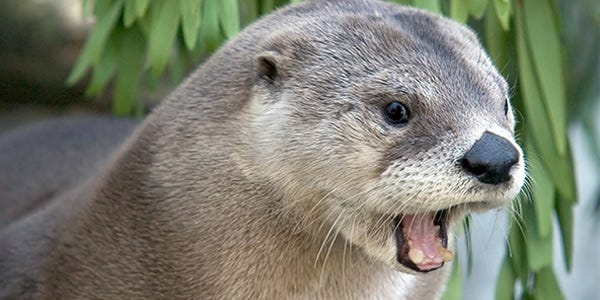Go West, Young...Otter?
One playful swimmer is making an appearance in Texas for the first time in years — ladies, gentlemen, and everyone betwixt and between — I give you, the river otter.

By the way, if you’re looking for a better way to hang out with A Boy and His Dog — and whoever else you follow on Substack, we really recommend using Meco. It’s free to try, cuts down on inbox clutter, and makes sure we never have to miss you too much. If you like it enough to buy, we get a small commission that lets us keep our fun facts free.
Kellye Mixon Bussey, a freelance photographer, was birdwatching on the East Beach of Galveston last fall, and found something…decidedly not a bird.
Bussey found a furry, slinky swimmer, with its webbed feet and river-hermit whiskers. A river otter.
Our heroine shared her pictures online, and was greeted with another surprise. They’re not even supposed to be here.
Well, they are — but it’s very rare to see them along the Gulf Coast. Not because they’re spectacularly rare (though they don’t tend to wander this far west very often) — it’s because our playful, furry little water noodles are shy.
We used to have a lot more of them, as a matter of fact. They once lived all over the state — northwest as far as the Panhandle, according to Texas Parks & Wildlife Department mammal specialist Dana Karelus.
Karelus told Texas Monthly that the otters still make their homes in much of North America’s waterways. Their thick fur provides insulation from pockets of air nestled into it. They’re adaptable and resilient, and can live — and thrive — in hot or cold climates.
The early American fur trade was hard on them, however. Russian trappers in Oregon once called sea otter pelts “soft gold.” Their pelts were highly prized, and used for everything from hats to bedding. River otters received the same treatment.
Water pollution and habitat loss also hurt their numbers, but there’s a silver lining — conservation efforts have paid off for the river rascals. TPWD removed the species from its list of vulnerable animals.
“We’re seeing otters in a lot of places they haven’t been seen in a long time,” including recently in the San Marcos River and in San Antonio, says Karelus. “Continuing westward expansion seems to be the trend.”
San Antonio’s KSAT reported in 2022 that a few had been spotted near Spring Branch between 2021 and 2022. They seem to have weathered the pandemic right along with the rest of us.

Where can you wander to check out an otter?
Well…you’ll need good planning and a little luck — they’re quick, especially in the water, and skittish around humans (though — give them credit, not without reason).
They’re known to live near Lake Summerville, Gonzales’ Palmetto State Park, and Houston’s Buffalo Bayou.
People have also spotted the critters in Anahuac National Wildlife Refuge, southwest of Port Arthur.
If you do spot one, Karelus urges you to post it in the Mammals of Texas project on iNaturalist, which she and her colleagues use to help track sightings.
And if you haven’t checked out iNaturalist already, and you love the great outdoors and all that lives in it (except, maybe, the fire ants) — boy, do I have an app for you to try.
And if you’re curious, here’s some extra info about the river critters:
Common Name: North American river otter
Latin Name: Lontra canadensis
Size: 2.5 to 5 feet long
Texas Habitat: The eastern half, with occasional sightings elsewhere, though expected to range westward within a few years again.
What do they eat: Don’t get any ideas. They’re opportunistic hunters. Whatever they can get their grubby little hands on, but usually fish, crustaceans (like river-dwelling crawfish) and frogs.
Lifespan: 11-13 years, though a few have lived around 20.
What sounds do they make: A lot of them. Cute ones too — they have surprisingly complex vocal communication, ranging from chips and squeaks, to growls, chuffs, and whistles.
How cute are they: Way cute. 11/10.
Sorry, y’all are going to have to ride in the back. My pup already called shotgun. Gotta be quicker than that. You almost had it.
But — keep checking back with us.
Most of my writing is free — so while you don’t have to subscribe to keep up, becoming a paid supporter, buying me a coffee, following along on Newsbreak and Medium with my other writing, or simply sharing the things I write; they’re all appreciated. And they keep me writing about the wild wonders of the world.
Til next time —
Happy tails, readers.


